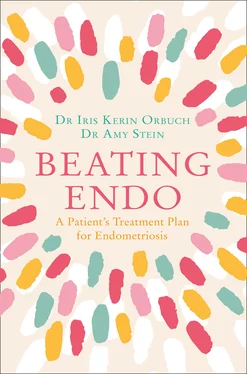The bottom line on this process of downregulation and up-strengthening is that it will require a number of changes only you can make, for they are effectively changes in your current lifestyle. You’ll almost certainly need to abandon ingrained habits and rethink routines that have become second nature. You’ll have to learn and instill new habits and routines until they become second nature. It will take time. It will take effort. Again, it may require undergoing excision surgery—the one thing you really can’t do on your own—and a process of post-op recovery. It certainly demands commitment. But it’s the way to bring your endo-battered body back to a level of strength and vigor that lets you regain the quality of your life.
How does it work? Meet three women who did it. Different ages, different backgrounds, different experiences of endo, and at different stages of life when they came to our attention and undertook the actions we recommended. But all three committed themselves to it, all three effected the changes needed, and all three have taken back their lives.
Here’s how they did it:
ELENA
At her first appointment, Elena sat across from Iris and announced: “I’ve been told I have stage one endometriosis and I have undergone ablation surgery,” a procedure in which the endo lesions are cauterized—“burned off” rather than rooted out. Elena wanted to know why, after all that, she still suffered what she described as “debilitating pain.”
Iris well knew of course that there is no correlation between the amount of endo in the body and the severity of the pain the endo sufferer experiences. She also knew that ablation surgery is ineffective in ridding the body of endo and may only temporarily—if that—relieve a patient’s pain. Elena had a lot to say about her pain. “I can’t function,” she began. “I can’t go to work.” (Elena was an administrative assistant in a hot-shot investment firm.) “I can’t have sex without pain.” (She was in a long-term relationship with a decidedly supportive man.) “I need to ask my mother for assistance to carry out simple household chores.
“Help me,” she said. “I want my life back.”
Iris began, as she always does, with one-on-one questioning. She asked Elena about her history with endo from the time her pain began—she was a teenager—to the present, age thirty-eight. Patients tend to become downright eloquent when they talk about their pain—especially patients like Elena who have lived with the pain for decades. They are well acquainted with it, and they believe they know everything there is to know about it. But in listening to what a patient says about her pain, the careful clinician needs to pierce that familiarity and draw out of the patient precisely what a doctor needs to know. Iris listened carefully. Then she went deeper.
She asked about Elena’s periods, which both were painful and produced an extremely heavy flow with clots. Elena told of having to leave a party because her menstrual flow soaked through and stained what she was wearing; her partner walked closely behind her as they snuck out as quickly and unobtrusively as possible. The pain, said Elena, was in no way limited to the time of menstruation but was felt at different times of the month. Iris recognized this as standard; the pain of endo can occur anytime.
Next Iris wanted to know about what Elena referred to as “stomach issues.” She had experienced these “issues” since she was a teenager, and Iris elicited from her that she consistently strained when trying to move her bowels and found it painful to do so. She also felt a squeezing sensation around her rectum, and when asked about back pain, said that hers was the result of a childhood softball injury when she triumphantly stole home and stepped down so hard on the plate that she felt it from her ankle to her shoulder. To this day, Elena said, that injury made sitting difficult—especially during the long commute to work. Iris suspected that long-term constipation and straining her muscles in response to endometriosis were really what was at issue in Elena’s pain, not stealing home base in high school.
Iris asked about her urological function, which Elena hadn’t even mentioned, but in response to questions, she told Iris that she got up a couple of times a night to urinate, urinated twelve to fifteen times during the day, and still felt pressure on her bladder. When Iris pressed the point, Elena recalled that she had had five “urinary tract infections,” as she dubbed them, the previous year, even though her urologist told her no bacteria were found in the test.
Moreover, Elena could not tolerate birth control pills, which one doctor had prescribed for her cramps, because they worsened her migraines and she couldn’t bear the pills’ side effects. Also, she had already undergone a full workup by a gastroenterologist, not to mention a colonoscopy, with results that, happily, were totally negative—nothing wrong with her.
There may have been “nothing wrong with her,” but none of the medical treatments she had undergone, including her ablation surgery, had alleviated her pain—no surprise to Iris. Elena was exhausted, and she was becoming depressed.
It was all of this that had finally prompted Elena to seek out a specialist. Her boss, a senior vice president at the firm, had heard about Iris and suggested Elena call. She made an appointment for a “single consultation only,” as she made clear; Elena was pretty sure she wouldn’t be able to afford going out of network more than once.
But she had never had a consultation like this. She had never been asked the kinds of questions Iris asked—how often she urinated, did she ever get constipated, her sex life—and that was before Iris even began to examine her! So she was surprised and extremely interested when Iris told her that the interview alone suggested that Elena was dealing with a number of systemic conditions—urological, gastrointestinal, musculoskeletal—all of which were super-sensitizing and thereby upregulating her central nervous system.
That was just for openers. As Iris went through her physical exam, Elena felt herself being probed carefully from head to toe, a probe that, from Iris’s point of view, confirmed her original assessment. Iris could feel the tightened muscles that told her Elena had abdominal and pelvic floor dysfunction. She noted the thickened ligaments behind the uterus, in the small space between the rectum and the back wall of the vagina and uterus known as the pouch of Douglas; thickened ligaments are a typical clue for endo. The pain that made Elena grunt when Iris pressed on Elena’s uterus confirmed the suspicion that she probably had adenomyosis as well—endo-like cells in the muscle of the uterus. Iris was convinced that Elena suffered both that syndrome known variously as interstitial cystitis or painful bladder syndrome and tight pelvic muscles. It was also possible, she surmised, that in Elena’s case, the endo implants were literally on the bladder.
Physical exam, questions asked and answered in detail, medical history: The aim was to translate a patient’s catalogue of symptoms into an analysis of system dysfunctions. For Iris, it was a way of decoding heavy menstrual bleeding, back pain, constipation, trouble sitting down, and all Elena’s other symptoms into a template of coexisting urological, gastrointestinal, and musculoskeletal conditions. And in its turn, it enabled the creation of a systems-based plan of treatment.
For Elena, learning that what was undermining her life was a panoply of conditions that began with endometriosis and that now coexisted with it was a revelation, but the realization that she needed to treat all of those conditions was a lot to absorb—especially after the false hope of ablation surgery. Yet in a very real sense, Elena was relieved to see this great, huge colossus of unreachable pain broken down into separate systems and into treatable conditions—with a plan for each.
Читать дальше











